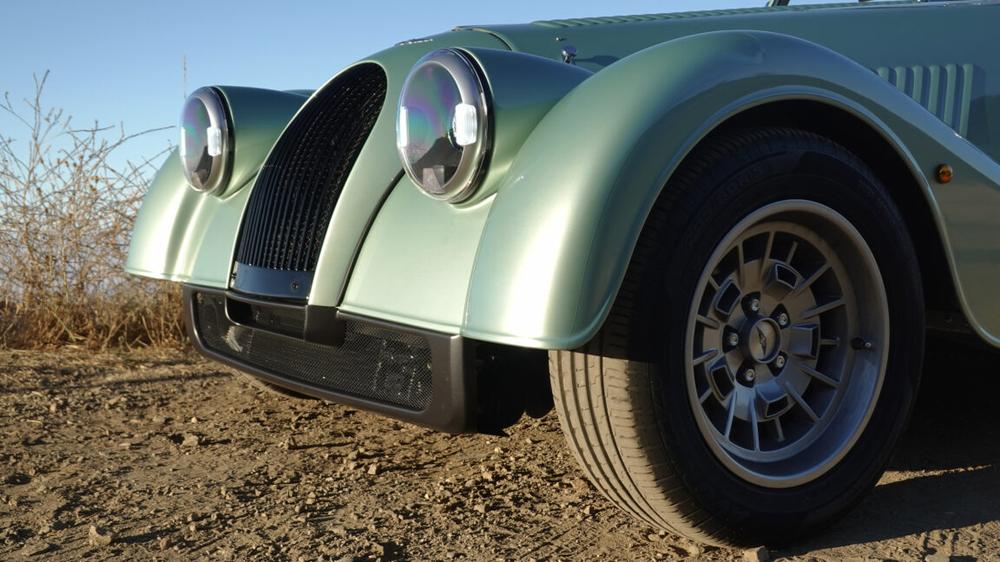Lift up either side of the new Morgan Plus Four’s engine decklid and no carburetors or velocity stacks materialize on the engine of this otherwise eminently classic-looking car. The latest generation of Plus Four returns to the American market this year for the first time since 2005. But to make it happen, Morgan spent five years homologating the little roadster with the National Highway Traffic Safety Administration, technically as a replica.
That's why, underneath the left-hand hood, a hilarious list of Federal Motor Vehicle Safety Standards exemptions lays out every way the Plus Four skips out on the usual fare, such as side impact protection, ejection mitigation, a hood latch system, and tire pressure monitoring. Apparently, that’s what it takes to produce a truly lightweight sports car in the modern era.
More importantly, this latest generation of the Plus Four, which debuted in 2020 in other regions, stays shockingly light by now using a bonded aluminum chassis to help with handling and rigidity while harnessing the power output of a modern BMW drivetrain. But Morgan still builds the body on an ash wood frame, proving that the old ways that allowed a tiny British coachbuilder to remain on the market as a low-volume manufacturer at a reasonable price may never truly die.
An auto? Really?
The price of this tiny sports car can still creep up to six figures fairly easily, though. And sadly—almost unbelievably—Morgan opted against shipping a manual option to the US, which I only learned a couple of days before I received a test loaner equipped with the ZF eight-speed automatic that now serves as the only option. Whether that recipe proves ripe for success or destined for a faceplant, the Plus Four at least grew up a bit over the two decades since Morgan last sold it here, so I fit fairly well at 6-foot-1 (1.85 m) with long legs.
Once I actually slipped inside, that is, since climbing in and out requires some fairly serious contortionism, especially with the roof up and door panels on. The aluminum chassis stretches the wheelbase by 3.2 inches (82 mm), and the two-seater cockpit offers slightly more space thanks to 1.5 inches (40 mm) of additional width and 1.2 inches (31 mm) of height gained. But surprisingly, the overall length actually shrinks by 7.1 inches (181 mm) due to to shorter overhangs ahead of and behind the tires.
My Plus Four’s Comfort Plus Seats provided plenty of cushion, if not much in the way of bolstering. In fact, hand bumps even control the lumbar support, though I never figured out how to use them. Meanwhile, the steering wheel moves up and down but doesn’t telescope, and most everything else on the dash sits more centrally, including a push-button start and all the controls for modern amenities, including air conditioning, Bluetooth-enabled audio, and the drive mode selections just ahead of the shifter.
That familiar BMW shifter looks absolutely out of place, serving as the main reminder that no clutch pedal can be found in the cramped pedal box. I struggle to comprehend the decision to only sell an automatic in the US, which seemingly cuts into the enthusiast market that Morgan specifically tailored this car to satisfy. And frankly, I enjoyed driving the Plus Four more aggressively, not just as a classy cruiser.
My test car also arrived equipped with the Dynamic Handling Pack, a $2,410.63 option that adds adjustable Nitron dampers, a rear sway bar, and stiffer rear springs (by approximately 3 percent). Working together, the suspension and bonded aluminum structure never clunked over bumps or awkwardly heaved on choppy roads, an impressive achievement given that the Plus Four weighs just 2,293 pounds (1,040 kg).
OK, this is fun
Start to push the turbocharged BMW inline-four a bit harder, though, and the 255 hp (190 kW) and 295 lb-ft (400 nM) of torque will make that lack of mass quite enjoyable. I easily broke the rear tires loose at full throttle or between hard upshifts at the top of the tachometer. Better yet, I even switched into Sport+ mode with the ESC turned off entirely to try some hilarious little drifts.
The center of mass lies slightly further forward over the nose than I expected, which because the rest of the car weighs approximately nothing and the tires measure a paltry 8 inches (205 mm) wide, makes for a fun and predictable tail-happy demeanor. And the steering, although heavy compared to many modern electronically assisted cars, still whips around easily to catch out any untoward shenanigans with a quick hit of opposite lock.
In Sport+, the optional active sports exhaust system ($2,827.50) also helps to impart a slightly more serious soundtrack. This one manages a bit of drama as turbo whine and intake rush creep in through a complete lack of sound insulation. Plus, the exhaust barks out back with little pops and bangs on throttle liftoff.
Without a doubt, nothing on the road can quite compare to a Plus Four today. What other lightweight sports cars even survived into the modern era, when a Porsche Boxster or even a Lotus Emira now weigh above 3,000 pounds (1,360 kg)? Only the Mazda MX-5, perhaps, which weighs slightly more, with swoopy modern styling and economy car materials on the inside.
Speaking of which, plenty on the Plus Four could use a bit more of a premium touch. The steering wheel looks reminiscent of a Lotus Elise or even an original Tesla Roadster, plasticky and cheap despite the leather and physical shape actually turning out fairly nice. A thin wood rim would go a long way, as would remedying some other questionable build quality decisions throughout.
More wood on the dash, rather than the standard painted silver, might reduce glare with the convertible top laid back. And even with the roof up and the removable door panels in place, the Plus Four never approaches anywhere near weatherproof, as I felt strong drafts from around my left elbow, and the sliding plexiglas windows entirely lack seals. The sun visor attachments also rattle incessantly, and the Sennheiser premium sound system can’t even bump loud enough to drown the annoyance out, so perhaps skip that $3,770 option.
Some of the Plus Four’s issues seem easily fixable: Remove the roof, forget the music, and torque down some fittings a bit more here and there. Needing to worry about such avoidable irritations in the first place, though, proves that Morgan may have modernized the car, but a certain level of classic British engineering still applies.
Even so, nothing else I’ve driven mixes driving pleasure and crowd pleasing at the level of the new Plus Four. At the price of $103,970 as tested, I simply cannot forgive the decision not to offer the choice of a manual transmission, which would transform this classy roadster into an entirely different animal indeed.

 The EU AI Act aims to create a level playing field for AI innovation: Here’s what it is
The EU AI Act aims to create a level playing field for AI innovation: Here’s what it is